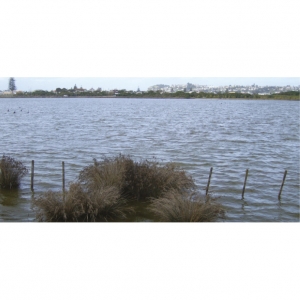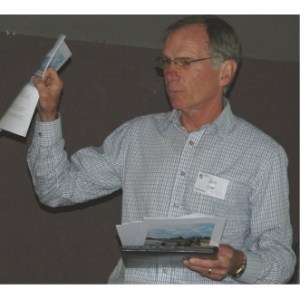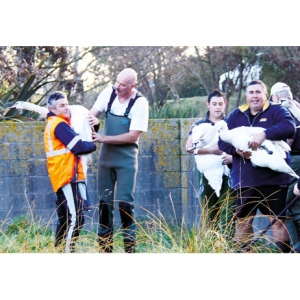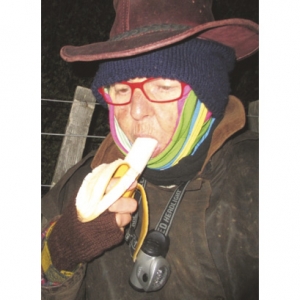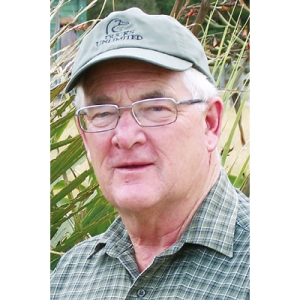Super User
Help at hand for Waikato wetlands
Tony Roxburgh, chair and trustee of the National Wetland Trust provided the AGM with a glimpse of happenings with wetlands in Waikato.
The Trust plans a state-of-the-art interpretation centre, with research and educational facilities, wetland gardens and heritage trails on land next to Lake Serpentine in the Waipa district. This is one of 69 peat lakes in Waikato.
Issues to be worked through include highway access and formal agreement with the Department of Conservation. DoC has already given approval to construct a 1.4 km predator fence around 10ha of the reserve at Lake Serpentine near Ohaupo.
Tony said the plan includes a visitor concept plan, an interpretation plan, business plan and landscape developed for the site. These were funded by grants from Transpower, Trust Waikato and Waikato Regional Council (Environmental Initiatives Fund), and supported by Waipa District Council.
They are looking at the best way to restore wildlife, including the feasibility of a predator exclusion fence. Funding from the Waikato Catchment Ecological Enhancement Trust, and a grant from the DoC’s Community Conservation Fund allowed them to produce a re-vegetation plan to restore vegetation and habitat.
Students of Te Awamutu School have been searching for native and exotic fauna, and have been the first to confirm long-tailed bats at the site. Other species confirmed include Australasian bittern, North Island fernbird, Black mudfish and Spotless crake.
The pest fence was completed in June this year and they now need sponsors and donations to help with pest eradication and re-introduction of native species.
Other work in the Waipa district includes Lake Ngaroto one of the peat lakes. It currently floods the peat and Tony said this could be one of the larger projects for the Waikato basin aimed at reducing loss of wetland and preserving the quality of the peat lakes.
Web Feet and Websites = Ducks Unlimited
It is satisfying to see the steady rise of Ducks Unlimited website usage over the last year. Contributing factors are the great work DU are doing in Wairio and country wide, the improvements we are making to the site, word of mouth and a substantial amount of traffic directed to us by Google searches, mostly people looking for information on our webfooted friends.
Also on a rise - the use of our facebook page with now 161 members . It is a great venue to share thoughts, facts and photos on conservation and wetlands. A great place to visit and scroll through the ‘posts’ to get news on DU and other conservation organisations. We are linked with many organisations through Facebook, sharing and exchanging relevant information, as is the social networking way.
I have proudly been involved with DU’s website and other promotional projects for about three years. In that time the site has had a bit of a facelift, new additions and plenty of changes. Work continues and we look forward to further use of these resources in the coming year.
If you have not visited our website or facebook site we urge you to:
DUCKS UNLIMITED www.ducks.org.nz
QUACKCLUB (kids club) www. quackclub.co.nz and
FACEBOOK www.facebook.com/pages/Ducks-Unlimited-NZ/142374525787862
Michelle Cooper
The birds’ place – the Ahuriri estuary
An interesting visited during the AGM Conference
was the long, narrow Ahuriri estuary. We travelled by bus, so there was no chance to dip a toe in the water. With its wide range of fresh to salty, shallow to deep, and sandy to muddy habitats the estuary supports a diverse range of birds, fish, invertebrates and plant life.
It is a sanctuary for a wide variety of wading birds including Grey herons, Royal spoonbills, Pied stilts, Shags, Kingfishers and Gannets. Over 70 species of resident and migratory
waterbirds use the estuary as a feeding and resting area. Bar-tailed godwits/kuaka, Knots and Golden plovers migrate here each year from their arctic breeding grounds.
Fun, games and serious stuff at AGM
Jim Law explained what is happening at Wairio Wetland in the southern Wairarapa when he presented the following at this year’s AGM.
During 2012/2013 restoration work increased significantly and the research programmes by Victoria University’s Wellington School of Biodiversity and Restoration Ecology were expanded to include nutrient studies and hydrology.
However, of greatest interest are plans we have been pursuing for some time to reticulate water from the neighbouring Mathews lagoon (and possibly boggy Pond), under the Parera Road and into the Wairio Wetland. This would be a great boost to the health of the Wetland and assist in stripping nutrients before the water finally reaches Lake Wairarapa.
This year’s increased work cost just over $25,000 (prior year $15,000), and was once again financially supported by the Nikau Foundation, Rotary, the Pharazon Trust and the Ron Greenwood Trust and the Estates of two former DU members, Bruce McKenzie and Ron Brookes. Greater Wellington Regional council also contributed funds received under the Government’s “Fresh Start for Fresh Water” programme. In total third parties contributed $15,000, with the balance of $10,000 coming from DU resources
For the 2013/2014 year we have an even higher budge of $35,000. Key items include our normal planting, led by DU’s Trevor Thompson and again involved a number of our stakeholders, notably pupils from the local Martinborough School, students from the Taratahi Agricultural Training Centre, Rotarians and other interested parties, including of course, DU members. Good local media coverage was provided by Gill Lundie, the Wairarapa Chapter Chair. Further planting is planned for late August brings the total for the year to 4000 plants – a record!
The other main 2013/2014 item that has been completed is the construction of a bund wall around the western side of Stage 4 that has retained significant water in the Wetland. Wairio is no definitely being seen as a success story by the wider community and DU’s profile has grown accordingly.
Catching up the swans
There is something majestic about Mute swans as they glide gracefully on the surface of a lake, no wonder they are in great demand.
Swan Upping* has been an annual event for Ducks Unlimited for about 28 years with some members travelling quite a distance to take part in “catching up the swans”.
Peacock Springs, now The Isaac Conservation and Wildlife Trust donates Mute swans to DU, and the swans contribute a major amount to DU’s yearly fund raising.
This year Ross Cottle and Jim Campbell brought seven swans north. Back in the North Island they collected all the birds that DU members have reared (in total 17) and they were taken to Ross’s place in Masterton to sort into breeding pairs for distribution to members who want them.
Catching the swans is called Swan Upping short for catching up the swans.
Two Cape Barren Geese were caught up in this event. They are Grey Geese native to the southern coast of Australia called Cape Barren. They have black feet, pink legs, a blue grey body and lime green beak. They have gone to long time DU member Mike Burke in northern Manawatu.
*Swan Upping is an annual ceremonial and practical activity in Britain in which Mute swans on the River Thames are rounded up, caught, marked, and then released.
Traditionally, the Monarch of the United Kingdom retains the right to ownership of all unmarked mute swans in open water, but only exercises ownership on certain stretches of the river and its surrounding tributaries. This dates from the 12th century, during which time swans were a common food source for royalty. Swan Upping is a means of establishing a swan census and today also serves to check the health of swans.
Photos: Catherine Ott, Peacock Springs.
Kiwi call monitoring at Tawharanui
In New Zealand we have our special icon, the Kiwi. This is the only country in the world where Kiwi live. They make their burrows in the undergrowth and enjoy running about searching for worms and spiders.
However, with such a lot of predators now, it is wise to have Kiwi either in a safely fenced or pest monitored area. At Tawharanui we have just that right situation, with the Predator Proof Fence across the Tokatu Point at the termination of Tawharanui Peninsular, giving freedom to all native creatures within.
Kiwi breed around Autumn each year, once they are old enough. This is about two years old. They like to call at twilight which is the two hours after the sun goes down. So Kiwi Call Monitoring occurs when volunteers sit during those two hours usually 6 – 8pm, in June each year, silently listening for the calls.
Once the first call is heard then a count is commenced, slowly, sometimes reaching to over 20 times. These are usually the male birds with their shrill high whistles. Then occasionally a female will call with her lower guttural tones. Sometimes, all is then quiet. Perhaps they have found their mate!
Once the two hours is completed the volunteers collect together again at their base for supper and a chat about their evening event.
Sitting out in the dark at this time can be very cold in New Zealand. So good warm woolly and dry clothing is essential. Usually dry nights with little wind are chosen. The moon is rarely visible. Try it sometime – it’s a thrilling experience!
Patti Williams
Largest wetland in Auckland area - Te Henga
Proposed predator control is vital for Habitat Te Henga and for the reintroduction and survival of many birds including pateke. John Sumich , Chair, Habitat Te Henga puts the case.
Matuku, Forest & Bird’s sanctuary, is approximately 120ha of regenerating mixed kauri and podocarps that merges into West Auckland’s Te Henga wetland, the largest in the Auckland area.
Visiting a dozen years or so ago, Sean O’Connor and Ossie Latham declared to John Staniland, the resident guardian, that it was ideal for pateke although the whole valley would need predator control. Finally in 2012 the current Pateke Recovery group leader Tiff Browne and Nigel Miller agreed the blend of forest, swamp, and farmlands offered all that pateke desire. With the large dune-impounded Lake Wainamu just over the ridge it would also be part of the habitat any released pateke would utilise so that (area) also needed predator control. And while you’re at it they’ll (pateke) probably use the small estuary at the beach so include that!
Since 2002 the Ark in the Park project had been steadily expanding predator control to the current 2400ha and its north western boundary is conveniently the eastern boundary of the suggested predator controlled area.
The Ark has successfully introduced robins, whitehead and kokako and has an extensive mustelid and rat control program. Additionally a volunteer beach care group have been controlling predators for some years and have seen the return of New Zealand dotterel for their efforts. Other volunteers run a trap line at the north of the beach where on a headland there are five species of shearwater; the highest number cohabiting on a mainland site.
I was able to get grants from WWF, and Auckland Council Biosecurity to purchase traps both DOC200s for mustelids [the stainless steel model owing to the proximity of the wild West coast salt air] and also Belisle kill traps for feral cats.
Although the existing trap lines at the beach and at Matuku are fairly short and well managed by volunteers the new requirements have two long trap lines each over 12km and therefore too long for a sustained fortnightly trap checking by volunteers. Another grant gained from the Auckland Zoo Conservation fund is for a contract trapper who will alternate the long lines.
Fernbird sightings and perhaps territories are to be recorded, as they believe fernbird will be an indicator species showing a positive response to predator control. Over 100 traps were placed during September and between volunteers doing the shorter lines and a contract trapper doing the long lines we hope to maintain the effort year round. So far the perimeter traps enclose over 1000ha.
Robins from the Ark in the Park sanctuary have dispersed and have been seen around the lake; a kokako has also visited Matuku and tomtit are now being seen at Matuku so the original vision of the Ark in the Park, “ From the ridges to the sea” could become a reality with this new venture aimed at bringing back pateke. The potential then is for other waterfowl and rails to become established in the wetland and gradually disperse upriver toward the Ark.
Check it out at forestandbird.org.nz
Canada needs wetlands (so does NZ)
Ducks Unlimited Canada are celebrating 75 years of existence this month, October 20013. In a special souvenir issue put out by the Calgary Herald there is a piece that explains why Canada needs wetlands. In New Zealand we need wetlands to be looked after as well, so here are the reasons given by the Canadians. These are reasons New Zealand can also take to heart.
Ducks Unlimited Canada are celebrating 75 years of existence this month, October 20013. In a special souvenir issue put out by the Calgary Herald there is a piece that explains why Canada needs wetlands. In New Zealand we need wetlands to be looked after as well, so here are the reasons given by the Canadians. These are reasons New Zealand can also take to heart.
Wetland - like marshes and ponds are some of the most productive ecosystems in the world. They work behind the scenes, providing many important benefits to all Canadians.
Clean water: wetlands filter harmful pollutants from the water we drink and improve the health of our lakes and rivers.
Homes for wildlife: hundreds of species depend on wetlands for food and raising their young.
Flood and drought prevention: wetlands act like giant sponges, holding water during wet periods and releasing it during dry periods. Fun and recreation: wetlands are beautiful places for people of all ages to be active and enjoy nature.
Given all they do, it is shocking that wetlands continue to be lost. Every day up to 80 acres of wetlands are lost in Canada. Your help is needed. Join Ducks Unlimited, Canada’s conservation community at www.ducks.ca
The following are excerpts from another article in that Calgary Herald publication linking science with nature and wetlands. This is already happening with the work DUNZ has
instigated at Wairio Wetland in the Wairarapa. In Southland Waituna Lagoon is also
attracting scientific interest.
Science is helping to increase the knowledge about wetlands and what they do. Ducks Unlimited Canada biologist Owen Steele said: “As one of the Earth’s most productive ecosystems, wetlands are also among the most threatened.
“A lot of people don’t care if wetlands are a good place for ducks or frogs or anything else, society is so urbanised we’ve lost touch with nature. “But if their home is going to get washed away of they’re no longer able to drink their tap water because of disappearing wetlands, they are suddenly interested. “
Steele says if the river that runs through their town is going to be green, scummy and unattractive to walk by, they are going to sit up and pay attention.
Research in North America clearly shows the critical environmental benefits wetlands provide, which include clean water and habitat for wildlife, reducing flooding and erosion and lessening the impact of climate change.
As wetlands are lost so too are the benefits they provide. These include phosphorus removal - without wetlands more phosphorus will go into our lakes and rivers.
There is also the carbon stored in wetlands. The biological diversity and the social benefits of wetlands start adding up. Landscape changes that include roading, rail lines and pipelines can all affect wetlands.
Owen Steel said: “Things like our jobs, the economy and our health are all important issues; we need to figure out a way to link wetland protection and conservation to those issues.
“We still have a long way to go in prevention of wetland loss.”
From the President
I am privileged to be the new DUNZ President appointed by my fellow DU Directors at our meeting at the Napier Conference in August. I thank them for their confidence and hope I can make as big a contribution to wetland and waterfowl conservation as our past President Ross Cottle. To Ross, a big thank you for your stewardship of DU over many years and I know as a Director you will continue to keep DU on track. To your wife Sharon, we really appreciate the support you have given Ross and DU. The strength of DU is based around its members and the sterling work of Liz Brook, editor of Flight, Jan Abel, secretary and Michelle Cooper, facilitator of the Quack Club and DU webmaster.
Our AGM in Napier was an outstanding success. We had a great venue and good attendance by members who supported the fund raising auction. The field trip on Saturday morning to Pekapeka Swamp was led by Steve Cave, Wetlands Manager with the Hawke’s Bay Regional Council who talked about their restoration programme for the wetland. They have an excellent interpretation trail with boardwalks which take you right into the middle of this wetland. Pekapeka is located on SH2 south of Hastings and is well worth a visit.
In the afternoon we visited the Ahuriri Estuary on the edge of Napier, now only 20 percent its former size following land uplift in the 1931 Napier earthquake and associated drainage work. Ahuriri is a very valuable estuarine wetland with a rich Maori history, high biodiversity values with a number of northern hemisphere breeding birds like godwit using the area in our summer, and diverse recreation values.
The future of wetlands is both exciting and challenging. Projects like Wairio in the Wairarapa where DU has gained the support of a diverse group of organisations and individuals in helping to restore this degraded wetland. It is a great model which should be extended to other regions where many other wetlands require help.
The future of wetlands is largely dependent on private landowners and organisations like DU, Fish & Game, Game Bird Habitat Trust, National Wetland Trust, DOC, QEII, Forest & Bird, Regional Councils, community biodiversity groups and others. We all have a strong interest in wetland conservation and often work independently of each other. I hope we can take advantage of every opportunity to work more closely together in future. It is important that legislation, like the Resource Management Act which underpins much of this work, is not weakened during the current review.
A decision has been made to hold the 2014 AGM in the Wairarapa at Brackenridge Country Retreat near Martinborough. Look forward to seeing you all there.
John Cheyne
Wetland Day 2014
Coming soon – World Wetlands Day, the Ramsar Convention’s annual campaign day February 2, 2014. The theme this year is
Wetland and Agriculture, a topic of relevance to almost everyone involved in wetlands!
Visit the Ramsar Secretariat’s web site www.ramsar.org to find out more. Hard and soft copy materials (poster, leaflet, cartoon etc), will be available. Write now to This email address is being protected from spambots. You need JavaScript enabled to view it. to receive hard copies and the
design files if you wish to customise their materials.


